#avoid foods for kidney disease
Text
youtube
Welcome back to our channel! In this video, we'll dive into a crucial topic concerning kidney health. Our kidneys play a vital role in maintaining overall health, filtering waste, regulating fluid balance, and controlling blood pressure. 👉 Subscribe to my channel to stay tuned: / @healthyhabitshub-zk9fz
✅Want to create automated professional videos? Visit the following link: https://pictory.ai/?ref=healthy46
🚫 Avoid These 6 Harmful Foods for Optimal Kidney Health:
1. Processed Foods: Ready-to-eat meals, canned soups, and fast food items are often high in sodium, which can lead to high blood pressure and kidney damage.
2. Sugary Drinks: Beverages like soda, energy drinks, and sweetened fruit juices are loaded with fructose, contributing to obesity and diabetes, both risk factors for kidney disease.
3. Red Meat: While red meat provides high-quality protein, excessive consumption can strain the kidneys. Metabolizing protein byproducts may lead to kidney damage and increase the risk of kidney stones.
4. Salt: A high-sodium diet can elevate blood pressure, a major risk factor for kidney disease. The kidneys regulate sodium levels, and excessive salt intake can impair kidney function. Choose low-sodium alternatives and monitor salt intake.
5. Caffeine: Caffeine, a diuretic, can increase urine production, potentially leading to dehydration and stressing the kidneys. Moderate caffeine consumption and staying adequately hydrated are essential for kidney health.
6. Alcohol: Chronic alcohol consumption can be damaging to the kidneys, leading to kidney disease and impaired function. Alcohol can also disrupt fluid and electrolyte balance, causing dehydration. Consume alcohol in moderation and be mindful of its impact on kidney health.
#kidney health#kidneys#protect your kidney#avoid foods for kidney disease#foods to avoid#how to keep your kidneys healthy#foods to avoid for kidney health#avoid these 6 harmful foods for optimal kidney health#be aware of kidney-damaging foods#6 worst foods that can damage your kidneys#ways to keep your kidneys healthy by avoiding foods#6 foods that can destroy your kidneys#harmful foods for optimal kidney health#Youtube
0 notes
Text
youtube
Welcome back to our channel! In this video, we'll dive into a crucial topic concerning kidney health. Our kidneys play a vital role in maintaining overall health, filtering waste, regulating fluid balance, and controlling blood pressure. 👉 Subscribe to my channel to stay tuned: / @healthyhabitshub-zk9fz
✅Want to create automated professional videos? Visit the following link: https://pictory.ai/?ref=healthy46
🚫 Avoid These 6 Harmful Foods for Optimal Kidney Health:
1. Processed Foods: Ready-to-eat meals, canned soups, and fast food items are often high in sodium, which can lead to high blood pressure and kidney damage.
2. Sugary Drinks: Beverages like soda, energy drinks, and sweetened fruit juices are loaded with fructose, contributing to obesity and diabetes, both risk factors for kidney disease.
3. Red Meat: While red meat provides high-quality protein, excessive consumption can strain the kidneys. Metabolizing protein byproducts may lead to kidney damage and increase the risk of kidney stones.
4. Salt: A high-sodium diet can elevate blood pressure, a major risk factor for kidney disease. The kidneys regulate sodium levels, and excessive salt intake can impair kidney function. Choose low-sodium alternatives and monitor salt intake.
5. Caffeine: Caffeine, a diuretic, can increase urine production, potentially leading to dehydration and stressing the kidneys. Moderate caffeine consumption and staying adequately hydrated are essential for kidney health.
6. Alcohol: Chronic alcohol consumption can be damaging to the kidneys, leading to kidney disease and impaired function. Alcohol can also disrupt fluid and electrolyte balance, causing dehydration. Consume alcohol in moderation and be mindful of its impact on kidney health.
#kidney health#kidneys#protect your kidney#avoid foods for kidney disease#foods to avoid#how to keep your kidneys healthy#foods to avoid for kidney health#avoid these 6 harmful foods for optimal kidney health#be aware of kidney-damaging foods#6 worst foods that can damage your kidneys#ways to keep your kidneys healthy by avoiding foods#6 foods that can destroy your kidneys#Youtube
0 notes
Text
10 Foods to Avoid with Kidney Disease and Diabetes- HealthifyMe
10 Foods to Avoid with Kidney Disease and Diabetes- HealthifyMe
Kidneys are bean-shaped organs containing blood vessels, which help balance minerals in the body, remove waste, and filter the blood. They help regulate blood pressure and make hormones that keep the body healthy. When the kidneys are damaged, they cannot perform this process properly. That causes waste to build up in your body and leads to other health problems. Many factors can lead to kidney…

View On WordPress
0 notes
Text
Can you lose weight by eating 800 calories a day?
While an 800-calorie diet can lead to weight loss, it's generally not recommended for most people. Here's a breakdown:
Rapid Weight Loss: It may cause rapid weight loss, but this can be unsafe and unsustainable.
Nutrient Deficiencies: Such a low-calorie intake makes it difficult to get all the essential nutrients your body needs.
Muscle Loss: You might lose muscle mass along with fat, which can slow metabolism and make weight loss harder in the long run.
Here's why a doctor's supervision is crucial for an 800-calorie diet:
Medical Conditions: It might not be suitable for people with certain health issues like diabetes or kidney disease.
Monitoring: A doctor can monitor your progress, ensure you get essential nutrients, and adjust the plan as needed.
Alternatives for Safe Weight Loss:
Focus on Whole Foods: Prioritize fruits, vegetables, whole grains, and lean protein sources.
Calorie Management: Create a moderate calorie deficit (consuming slightly fewer calories than you burn).
Portion Control: Use smaller plates and bowls to avoid overeating.
Move Your Body: Engage in regular exercise for calorie burning and overall health.
Consulting a Doctor or Registered Dietitian:
They can create a safe and personalized plan based on your individual needs and health goals.
They can guide you on portion control, healthy food choices, and incorporating exercise.
I will give you a weight loss meal plan 1200 calories
#i wanna lose weight#need to lose more weight#anor3c1a#tw weight#weight loss#weight mention#bulemiia#anasp0#bonespø#thinspø#anorecyc#anorexla#@n@ tips#@na rules#@nor3xia#@n@ diary#@na motivation#@na vent#@na buddy#⭐️ ing motivation#⭐️rving#⭐️vation goals#⭐️ve#4nerex1a#4n4t1ps#4n4blr#4n0rexic#bulim14#bul1m14#tw weighloss
8 notes
·
View notes
Text
Cancer Prevention Tips: Lifestyle Changes for Reducing Risk
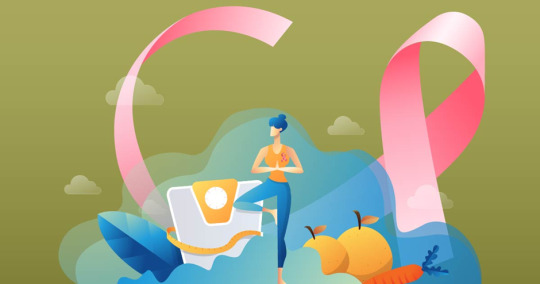
Introduction:
Cancer is a complex disease influenced by a variety of factors, including genetics and environmental exposures. While not all cancers can be prevented, adopting certain lifestyle changes can significantly reduce your risk of developing cancer. In this blog, we will explore important cancer prevention tips that can empower you to make proactive choices for a healthier life.
1. Quit Smoking:
Tobacco use is one of the leading causes of preventable cancers. Quitting smoking and avoiding exposure to secondhand smoke can dramatically reduce your risk of lung, throat, mouth, and other types of cancers. Seek support from healthcare professionals, join cessation programs, and utilise nicotine replacement therapies to help you quit smoking successfully.
2. Maintain a Healthy Weight:
Excess body weight, particularly obesity, is linked to an increased risk of several cancers, including breast, colorectal, pancreatic, and kidney cancers. Adopting a healthy eating plan that includes a variety of fruits, vegetables, whole grains, and lean proteins, along with regular physical activity, can help you achieve and maintain a healthy weight.
3. Follow a Balanced Diet:
A nutritious diet rich in fruits, vegetables, and whole grains provides essential vitamins, minerals, and antioxidants that can help reduce cancer risk. Limit consumption of processed and red meats, high-sugar foods, and beverages. Instead, opt for a diet that is predominantly plant-based, including plenty of fibre, while minimising processed and sugary foods.
4. Stay Active:
Engaging in regular physical activity can lower the risk of various cancers, including breast, colorectal, and endometrial cancers. Strive for at least 150 minutes of moderate-intensity exercise or 75 minutes of vigorous-intensity exercise per week. Incorporate activities you enjoy, such as walking, swimming, cycling, or dancing, to make it a sustainable part of your lifestyle.
5. Protect Your Skin:
UV radiation from the sun and tanning beds is a significant risk factor for skin cancer. Protect your skin by seeking shade, wearing protective clothing, using sunscreen with a high SPF, and avoiding indoor tanning. Regularly examine your skin for any changes, such as new moles or growths, and consult a dermatologist if you notice anything suspicious.
6. Limit Alcohol Consumption:
Excessive alcohol consumption is associated with an increased risk of several cancers, including those of the mouth, throat, liver, and breast. If you choose to drink, do so in moderation. The recommended limits are up to one drink per day for women and up to two drinks per day for men.
Conclusion:
By incorporating these cancer prevention tips into your daily life, you can significantly reduce your risk of developing various types of cancers. Remember that small changes can make a big difference. Quitting smoking, maintaining a healthy weight, following a balanced diet, staying physically active, protecting your skin, and moderating alcohol consumption are essential steps towards reducing your cancer risk.
In addition to these lifestyle changes, it's important to stay up to date with recommended cancer screenings and seek regular medical check-ups. Early detection plays a crucial role in successful cancer management.
Empower yourself with knowledge and take charge of your health. By making informed choices and adopting a healthy lifestyle, you can actively reduce your risk of cancer and promote overall well-being. Your actions today can pave the way for a healthier and cancer-free future.
For more details click on the link 👇🏻
https://bit.ly/3osreVo
#HopeAgainstCancer#ICANWIN#YESITSRAM#FightAgainstCancer#CancerAwarenessMatters#TogetherAgainstCancer#CancerWarriorsUnite#EmpoweredByHope#RaisingCancerAwareness#IgniteTheFight#ConquerCancerTogether#InspireHopeForSurvivors#CancerFreeFuture#CancerAwareness#CancerSupport#CancerSurvivor#CancerFighter#CancerCommunity#CancerResearch#CancerPrevention#CancerFree#EndCancer#StandUpToCancer#CancerJourney#CancerWarrior#CancerAware#CancerThrive#NoOneFightsAlone
46 notes
·
View notes
Text

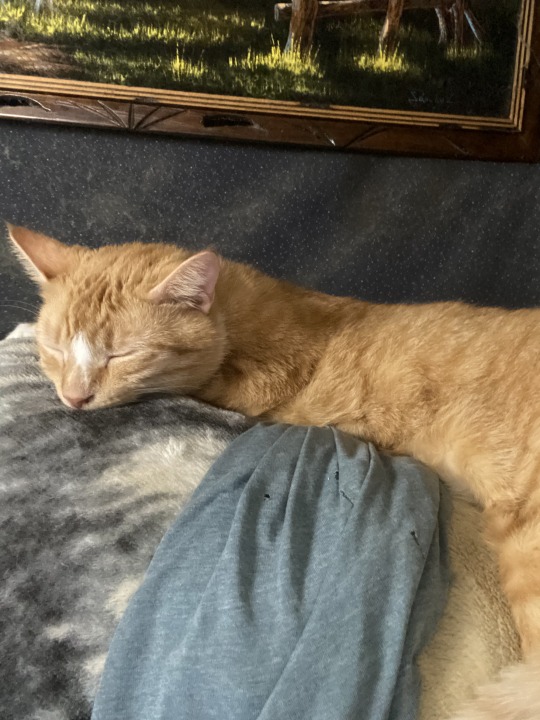
Before I post photos of Jensen from the con last weekend I wanna make a post to apologize for the lack of posts here. Normally I’m on top of anything Jensen & Jared during con weekends. But last weekend was a scary weekend for me. Last Friday I noticed my handsome boy Scooter was peeing blood. At first I wasn’t too sure it was blood I just knew it was not Casper. He tends to pee in the corner of the litter box. Scooter pees in the middle of the litter box or sometimes on the left side of the litter box. For the record before I go on yes I have 1 litter box for 2 cats. I know you are supposed to have 1 litter box for each cat plus an extra. So technically you should have 3 litter boxes. Well I don’t have the space for more than 1 litter box. Plus I can’t afford to buy litter for each box. So I have 1 extra large litter box which is enough for both of my boys. They each have a side of the litter box and I never have any issues with them sharing. Plus it is easy to monitor their bathroom habits/leavings.
Anyway back to Scooter I didn’t know it was blood until I saw him come in and actually pee blood in the litter box. At first I was going to wait til Monday to take him but when he started straining I knew it couldn’t wait. I took him to the emergency vet Saturday. Turns out he has what the call feline lower urinary tract disease basically an UTI. His bladder was full of blood which was scary. He wasn’t blocked but if I had not gotten him there when I did he could have become blocked. Which would have been fatal. The vet was originally talking surgery and a 2 to 3 day stay in the vet hospital. Which would have cost up to $6,000. No way I could have done that so my choice would have been surrender him and they would have gave him a new home after he was better or put him to sleep. So either way I would have lost him and that was NOT an option. The vet said it could be possible to avoid that if his kidney were functioning properly. Luckily his kidneys are normal and functioning properly. So the recommendation was a 24 hour stay to over hydrate him to flush his bladder out. I hated leaving him there cause I didn’t want him to think he was being abandoned. They let me see him before I left. I told him I love him he needed to get better and I was not leaving him that I would be back.
Next day we got a call that he responded well to treatment and he was ready to come home. He was sent home with antibiotics and for some reason 2 pain medications. He does have to be on prescription urinary dry & wet food. This will prevent crystals from forming causing stones which will cause him to get blocked. Thursday he had a check up and he is doing good responded well to the antibiotics. I asked if he could have Purina urinary food cause it is cheap and easy to get. Vet said nope it has to be either Royal Canin or Hill’s prescription food. Over the counter urinary foods don’t have what he need. We went with Hill’s but sadly it is very expensive. It’s $32 for a 4lb bag & $2 or $6 a can for wet food. But I have no choice if I want to prevent him from getting sick again. The vet said it was even safe to have Casper on it too. Cause it’s easier to transition them to the same food than to separate them. I can’t believe it’s been a week since everything happened.
Sometimes I doubt myself as a fur. Sometimes I think I get paranoid when it comes to my 2 cats & pup. But I’m glad I went with my instincts when it came to Scooter. Everyone who knows me knows Scooter means the world to me. Scooter was given to me as a birthday gift in October 2018. I was sick on my birthday so I was upset. 2 days after my birthday my dad found this tiny orange kitten who was 3 weeks old. They could not find his mother so my dad brought him home to me as a gift. I raised him since he was 3 weeks. Since he couldn’t eat food yet I bottled fed him. I set up a safe bed area for him. I would help him get to sleep and litter trained him. He will be 5 on Oct 5th as I estimated that is when he was born. I couldn’t imagine my life without him. It will be a struggle to pay for his food but it is worth it to keep him healthy and with me where he belongs.
Sorry this is so long but I needed to let it out. My life this year has been one shit storm after another. I’m just grateful to still have my baby boy with me.
10 notes
·
View notes
Text
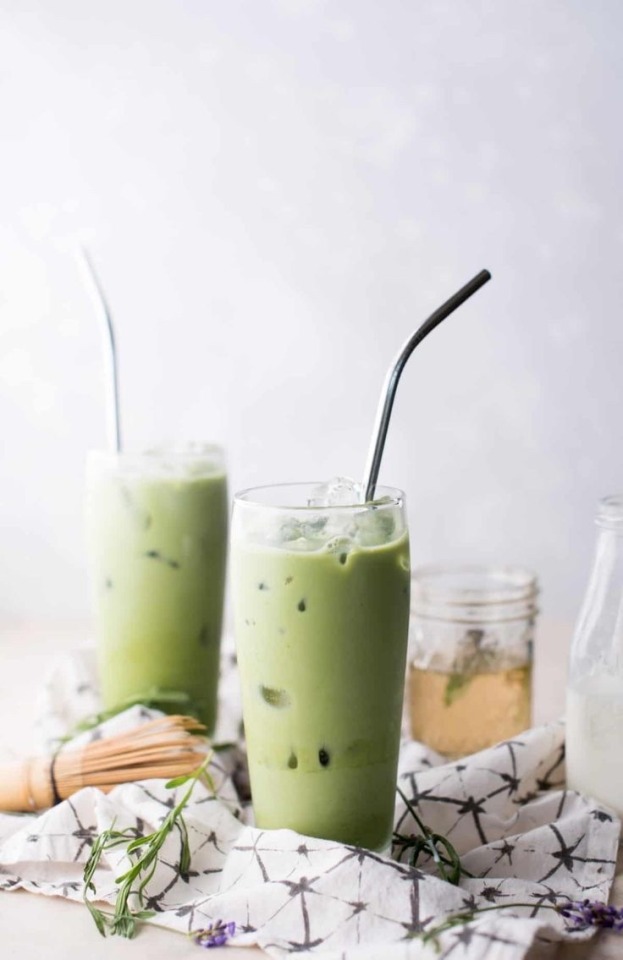
Eating a heart-healthy diet is essential for maintaining cardiovascular health and reducing the risk of heart disease. Here are some food sources that are great for heart health:
1. Fatty Fish:
Fatty fish like salmon, mackerel, sardines, and trout are rich in omega-3 fatty acids, which have been shown to reduce inflammation, lower blood pressure, and decrease the risk of heart disease.
2. Berries:
Berries such as strawberries, blueberries, raspberries, and blackberries are packed with antioxidants, fiber, and vitamins that help lower blood pressure, reduce inflammation, and improve cholesterol levels.
3. Nuts:
Nuts like almonds, walnuts, and pistachios are rich in healthy fats, fiber, and antioxidants that can help lower cholesterol levels and reduce the risk of heart disease.
4. Dark Chocolate:
Dark chocolate with a high cocoa content (at least 70%) is rich in antioxidants called flavonoids, which have been shown to improve heart health by lowering blood pressure, improving blood flow, and reducing the risk of heart disease.
5. Whole Grains:
Whole grains like oats, brown rice, quinoa, and whole wheat are rich in fiber, vitamins, and minerals that can help lower cholesterol levels, reduce inflammation, and improve heart health.
6. Leafy Green Vegetables:
Leafy greens such as spinach, kale, and Swiss chard are high in vitamins, minerals, and antioxidants that can help lower blood pressure, improve cholesterol levels, and reduce the risk of heart disease.
7. Avocado:
Avocados are rich in monounsaturated fats, fiber, and potassium, which can help lower cholesterol levels, reduce inflammation, and improve heart health.
8. Olive Oil:
Extra virgin olive oil is a heart-healthy fat that is rich in antioxidants and monounsaturated fats, which can help lower cholesterol levels, reduce inflammation, and improve heart health.
9. Legumes:
Legumes like lentils, chickpeas, black beans, and kidney beans are high in fiber, protein, and antioxidants that can help lower cholesterol levels, reduce blood sugar levels, and improve heart health.
10. Green Tea:
Green tea is rich in antioxidants called catechins, which have been shown to improve heart health by lowering cholesterol levels, reducing inflammation, and promoting healthy blood vessel function.
Incorporating these heart-healthy foods into your diet can help support cardiovascular health and reduce the risk of heart disease. Additionally, maintaining a balanced diet, staying physically active, managing stress, and avoiding smoking are all important factors in maintaining a healthy heart.
#food diary#food log#comfort food#fast food#healthy food#food photography#foodie#food#foodpics#foodlover#japanese food#foodmyheart#healthy salad recipes#lunch recipes#pasta recipes#pasta recipe#salad recipes#soup recipe#recipe#recipies#recipes#cozy autumn#cozy fall#cozy cozy#cozyhome#cozy living#autumn cozy#cozy art#cozy mystery#cozy vibes
4 notes
·
View notes
Text
Something I see online that's frustrating to me is you'll get people telling the vegan activists who promote veganism as a universal ideal that there are disabled people who can't have a vegan diet, but then a lot of the people who point this out don't seem to know what conditions actually cause that. And then you end up having arguments about that so I want to actually point out a few examples
I think the number one example where there's no way to safely, healthfully avoid having to consume animal products is haemodialysis for kidney failure. People on dialysis need more protein than other people because they lose protein and blood cells during the dialysis process, and they are required to have a low potassium diet because their kidneys can't filter potassium. This means legumes and soy aren't viable alternatives. [x] "Renal dietitians encourage most people on haemodialysis to eat high-quality protein because it produces less waste for removal during dialysis. High-quality protein comes from meat, poultry, fish, and eggs." [x] If you can't meet your protein needs with these foods for whatever reason, you'll be prescribed whey protein powder, which is made from dairy. [x]
Ketogenic diets are also high in animal proteins. They're innately low carb and high in fat, which means legumes and other meat alternatives aren't a great fit. "The ketogenic diet can boost insulin sensitivity and cause fat loss, leading to significant health benefits for people with type 2 diabetes or prediabetes." [x] PCOS, a common condition effecting about 10% of people who menstruate, is also often treated with a low carb, high protein diet because it involves insulin resistance. [x]
Ketogenic diets may also be recommended to treat seizures in epilepsy. [x] It is most frequently used for focal seizures in children, infantile spasms, Rett syndrome, tuberous sclerosis complex, Dravet syndrome, Doose syndrome, and GLUT-1 deficiency. In these conditions, ketogenic diets can reduce or even eliminate seizures.
People with food allergies can find it difficult to afford safe and healthy food in general. [x] The inability to rely on cheap, plant-based proteins like canned beans or dried lentils can be a general hardship, especially when disabilities themselves can limit job opportunities or the capacity to work.
Intestinal disorders are another factor that can make vegan diets difficult. Foods high in insoluble fibre, like beans and other legumes, as well as nuts and seeds, can cause Crohn's flare ups in some people. [x] Seeds, nuts, and legumes can also be trigger foods for people with ulcerative colitis. [x] IBD flare ups are not like a run-of-the-mill case of intestinal discomfort. They can land people in the hospital and require major surgery. [x]
For allergies, the main factor that can make a vegan diet difficult isn't allergy to specific vegetables, but to specific plant proteins. Someone who is allergic to soy, peanuts, or other legumes will have more limited options for meeting their daily protein requirements on a vegan diet. People with allergies to a broad spectrum of legumes may not have any reasonable substitution options. Substitutions can also increase the price point and make a vegan diet too expensive for people in poverty who also have allergies. Poor people with food allergies may find it difficult in general to afford a safe and healthy diet. [x]
For some people, including some disabled people, a vegan diet may in fact be ideal. Vegan diets can certainly be part of a healthy diet when trying to reduce bad cholesterol [x], treat high blood pressure [x], or treat earlier stages of kidney disease. [x] And while insulin resistance may be best treated with a ketogenic diet in some people, others do seem to benefit from a plant-based diet instead. [x] A person's diabetes specialist and trained dietitians can help them figure out which is best for them, potentially based on other factors like whether or not they have high blood pressure or bad cholesterol, or whether their diabetes risks are linked to PCOS or other known metabolic conditions.
Achieving sustainable food production and equal access to a safe, nutritious, well-balanced diet is fundamental to us all. But there's simply no one-size-fits-all ideal human diet, and that's something everyone needs to take into account.
30 notes
·
View notes
Text
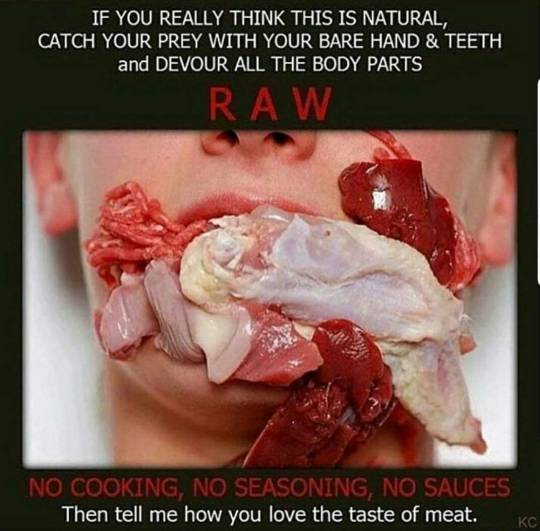
Research has shown that all meat eaters have worms and a high incidence of parasites in their intestines. This is hardly surprising given the fact that dead flesh (cadaver) is a favorite target for microorganisms of all sorts. A 1996 study by the United States Department of Agriculture (USDA) showed that nearly 80 percent of ground beef is contaminated with disease-causing microbes. The primary source of these bugs is feces. A study conducted by the University of Arizona found there are more fecal bacteria in the average kitchen sink than in the average toilet bowl. The germs and parasites found in meat weaken the immune system and are the source of many diseases. In fact, most food poisonings today are related to meat-eating. During a mass outbreak near Glasgow, 16 out of over 200 infected people died from the consequences of eating E. coli contaminated meat. Frequent outbreaks are reported in Scotland and many other parts of the world. More than half a million Americans, most of them children, have been sickened by mutant fecal bacteria (E. coli) in meat. These germs are the leading cause of kidney failure among children in the United States. This fact alone should prompt every responsible parent to prevent their children from eating flesh foods... Parasite Cleanse Diet – Foods To Eat And Foods To Avoid
One of the best ways to help the body destroy and get rid of unwanted parasites is following a parasite cleanse diet. This diet should be taken for at least 2 months to give your body an opportunity to get rid of all kinds of parasites and eggs that are hidden in different organs.
Parasites in the body can originate from several sources, such as raw meat, tainted water, pets or other animals.
They can cause symptoms like: digestive disorders, fatigue, food cravings and unstable blood sugar.
A good parasite cleanse diet involves eating herbs and natural whole foods that will help the body eliminate parasites.
The diet should have high mineral and nutrient content and shouldn’t contain any kind of artificial stimulants.
Here are some of the common foods and herbs that should be included in a good parasite cleansing diet.
You can find them at your local grocery store or health food store.
Wormwood, Garlic, Cloves, Black Walnut Hulls, Green leafy Vegetables, Coconut oil, Papaya, Green onions, Pineapple, Pumpkin seeds, cranberry juice (unsweetened), Fennel seed tea, Pungent spices clear out parasites, Spices like cayenne, chilies, horseradish, turmeric, cinnamon, nutmeg, cardamom, and cloves all make parasites disappear.
Foods to Avoid...avoid sugar, Sugar feeds parasites and also eats up the supply of B vitamins and minerals in the body. A parasitic infection may lead to cravings for carbohydrates and refined sugar, so it’s best to avoid these kinds of food to starve parasites off their energy and fuel. Refunded carbohydrates, like cakes, bread, cookies, cereal and pasta should be avoided. All of these lead to major fluctuations in blood sugar control and therefore put an extra strain on an already burdened system that’s infected with parasites.
11 notes
·
View notes
Text
First-Year Puppy Vaccinations

When you bring that fuzzy ball of puppy energy into your home, you know right away that your new puppy depends on you for, well, everything. It’s up to you to give your new puppy all the care they need every day. It can be a little intimidating — your puppy needs the best puppy food, plenty of attention, puppy training, puppy-safe toys, puppy socialization, a comfortable place to sleep, and proper veterinary care. And that includes making sure to schedule puppy shots throughout your puppy’s first year.
Which Shots Do Puppies Need?
Going to the vet over several months for a series of puppy vaccinations—and then for boosters or titers throughout your dog’s life—may seem inconvenient, but the diseases that vaccinations will shield our puppies and dogs from are dangerous, potentially deadly, and, thankfully, mostly preventable.
We read about so many different dog vaccinations, for so many different illnesses, that it can sometimes be confusing to know which vaccinations puppies need and which puppy shots are important but optional. Here is an overview of the diseases that puppy vaccinations will help your pet avoid.
Bordetella Bronchiseptica
This highly infectious bacterium causes severe fits of coughing, whooping, vomiting, and, in rare cases, seizures and death. It is the primary cause of kennel cough. There are injectable and nasal spray vaccines available.
If you plan on boarding your puppy in the future, attending group training classes, or using dog daycare services, often proof of this vaccination will usually be required.
Canine Distemper
A severe and contagious disease caused by a virus that attacks the respiratory, gastrointestinal (GI), and nervous systems of dogs, raccoons, skunks, and other animals, distemper spreads through airborne exposure (through sneezing or coughing) from an infected animal. The virus can also be transmitted by shared food and water bowls and equipment. It causes discharges from the eyes and nose, fever, coughing, vomiting, diarrhea, seizures, twitching, paralysis, and, often, death. This disease used to be known as “hard pad” because it causes the footpad to thicken and harden.
There is no cure for distemper. Treatment consists of supportive care and efforts to prevent secondary infections, control symptoms of vomiting, seizures and more. If the animal survives the symptoms, it is hoped that the dog’s immune system will have a chance to fight it off. Infected dogs can shed the virus for months.
Canine Hepatitis
Infectious canine hepatitis is a highly contagious viral infection that affects the liver, kidneys, spleen, lungs, and the eyes of the affected dog. This disease of the liver is caused by a virus that is unrelated to the human form of hepatitis. Symptoms range from a slight fever and congestion of the mucous membranes to vomiting, jaundice, stomach enlargement, and pain around the liver. Many dogs can overcome the mild form of the disease, but the severe form can kill. There is no cure, but doctors can treat the symptoms.
Canine Parainfluenza
This is one of several viruses that can contribute to kennel cough.
Coronavirus
The canine coronavirus is not the same virus that causes COVID-19 in people. COVID-19 is not thought to be a health threat to dogs, and there is no evidence it makes dogs sick. Canine coronavirus usually affects dogs’ gastrointestinal systems, though it can also cause respiratory infections. Signs include most GI symptoms, including loss of appetite, vomiting, and diarrhea. Doctors can keep a dog hydrated, warm, and comfortable, and help alleviate nausea, but no drug kills coronaviruses.
Heartworm
When your puppy is around 12-to-16 weeks, talk to your vet about starting a heartworm preventive medication. Though there is no vaccine for heartworm in dogs, it is preventable with regularly administered heartworm medication that your veterinarian will prescribe.
The name is descriptive — these worms lodge in the right side of the heart and the pulmonary arteries (that send blood to the lungs), though they can travel through the rest of the body and sometimes invade the liver and kidneys. The worms can grow to 14 inches long and, if clumped together, block and injure organs.
A new heartworm infection often causes no symptoms, though dogs in later stages of the disease may cough, become lethargic, lose their appetite or have difficulty breathing. Infected dogs may tire after mild exercise. Unlike most of the conditions listed here, which are passed by urine, feces, and other body fluids, heartworms are transmitted by mosquitoes. Therefore, diagnosis is made via a blood test and not a fecal exam.
Kennel Cough
Also known as infectious tracheobronchitis, kennel cough results from inflammation of the upper airways. It can be caused by bacterial, viral, or other infections, such as Bordetella and canine parainfluenza, and often involves multiple infections simultaneously. Usually, the disease is mild, causing bouts of harsh, dry coughing; sometimes it’s severe enough to spur retching and gagging, along with a loss of appetite. In rare cases, it can be deadly. It is easily spread between dogs kept close together, which is why it passes quickly through kennels. Antibiotics are usually not necessary, except in severe, chronic cases. Your vet may prescribe a dog-safe cough suppressant to help your dog (and you) get some rest, and some dog-safe throat soothers can help make a dog more comfortable.
Leptospirosis
Unlike most diseases on this list, Leptospirosis is caused by bacteria, and some dogs may show no symptoms at all. Leptospirosis can be found worldwide in soil and water. It is a zoonotic disease, meaning that it can be spread from animals to people. When symptoms do appear, they can include fever, vomiting, abdominal pain, diarrhea, loss of appetite, severe weakness and lethargy, stiffness, jaundice, muscle pain, infertility, kidney failure (with or without liver failure). Antibiotics are effective, and the sooner they are given, the better.
Lyme Disease
Unlike the famous “bull’s-eye” rash that people exposed to Lyme disease often spot, no such telltale symptom occurs in dogs. Lyme disease (or borreliosis) is an infectious, tick-borne disease caused by a type of bacteria called a spirochete. Transmitted via ticks, an infected dog often starts limping, his lymph nodes swell, his temperature rises, and he stops eating. The disease can affect his heart, kidney, and joints, among other things, or lead to neurological disorders if left untreated. If diagnosed quickly, a course of antibiotics is extremely helpful, though relapses can occur months or even years later.
Talk to your vet about when your puppy will be old enough for tick preventatives. Once your puppy is old enough, keep your dog on tick preventative medication, topicals, or wearables to help stop ticks from biting in the first place.
Parvovirus
Parvo is a highly contagious virus that affects all dogs, but unvaccinated dogs and puppies less than four months of age are at the most risk to contract it. The virus attacks the gastrointestinal system and creates a loss of appetite, vomiting, fever, and often severe, bloody diarrhea. Extreme dehydration can come on rapidly and kill a dog within 48-to-72 hours, so prompt veterinary attention is crucial. There is no cure, so keeping the dog hydrated and controlling the secondary symptoms can keep him going until his immune system beats the illness.
Rabies
Rabies is a viral disease of mammals that invades the central nervous system, causing headache, anxiety, hallucinations, excessive drooling, fear of water, paralysis, and death. It is most often transmitted through the bite of a rabid animal. Treatment within hours of infection is essential, otherwise, death is highly likely. Most states require regular rabies vaccinations. Check with your vet about rabies vaccination laws and requirements in your area.
Talk with your veterinarian about more information and guidance on necessary and optional vaccinations.
Puppy Vaccination Schedule
The first thing to know is that there is not just one puppy vaccination schedule for all dogs. Factors such as which part of the country you live in, and your dog’s individual risk factors will come into play. Some dogs do not need every vaccine. This decision is between you and your veterinarian. Always discuss puppy vaccinations at your regularly scheduled appointments.
That said, here is a generally accepted guideline of the puppy vaccination schedule for the first year.
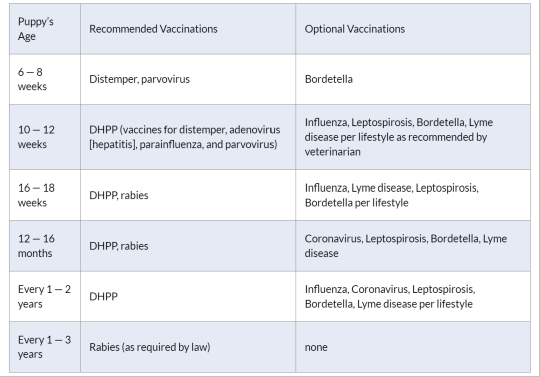
How Much Do Puppy Vaccinations Cost?
How much puppy vaccinations will cost depends on several factors. Where you live is a big one: Veterinarians in crowded and expensive urban areas will generally charge more than a rural vet in a small town. You may be able to find low-cost clinics providing rabies vaccinations sponsored by your local municipal government. But no matter what the range in costs, some vaccines, such as the “core vaccines” and rabies, are necessary.
The average cost can average around $75—100. These will include the core vaccines, which are administered in a series of three: at 6-, 12-, and 16 weeks old.
The core vaccines include the DHLPP (distemper, hepatitis, leptospirosis, parvo, and parainfluenza). Your pup will also need a rabies vaccination, which is usually around $15—20. (Some clinics include the cost of the rabies vaccination.)
Often animal shelters charge less for vaccines — approximately $20 — or are even free. If you acquired your dog from a shelter, he would most likely have been vaccinated, up until the age when you got him.
The initial puppy vaccination costs during the first year are higher than during adulthood.
Vaccinations for Adult Dogs: Boosters and Titers
There is a difference of opinion about having your adult dog vaccinated every year. Some vets believe too many vaccinations in adult dogs pose health risks. But others disagree, saying that yearly vaccinations will prevent dangerous diseases such as distemper. Talk with your vet to determine what kind of vaccination protocol works for you and your dog.
Many dog owners opt for titer tests before they administer annual vaccinations. Titer tests measure a dog’s immunity levels, and this can determine which, if any, vaccinations are necessary. One key exception to this is rabies: a titer test is not an option when it comes to the rabies vaccine. This vaccination is required by law across the United States. Your vet can tell you the schedule for your particular state, with boosters often lasting three years.
And it’s all worth it. For your effort and care your puppy will lavish you with lifelong love in return. This critical first year of her life is a fun and exciting time for both of you. As she grows physically, the wonderful bond between you will grow, too.
#puppy vacinations#puppy vaccines#puppy shots#puppy shots schedule#dog vaccinations#dog health#puppy health
4 notes
·
View notes
Video
@sonofawinchester I'm disabled and on a low income. Please help me save my feathered daughter. Linktree in bio #foryou #cockatiel #help #vetbill #emergency #birddad
♬ original sound - sonofawinchester
tiktok
PLEASE READ AND MAKE THIS GO VIRAL.
I know it's a long read, but it's so important, and I am LITERALLY BEGGING YOU FOR HELP! (And including the link to the original tiktok video because apparently tumblr doesn’t want to show it: https://www.tiktok.com/@sonofawinchester/video/7139692736252349739?is_copy_url=1&is_from_webapp=v1)
I have had nothing but hardships since June, and am on the brink of losing everything. Our well pump died suddenly, and I went two weeks without water, begging the local gov't to help, to no avail. Instead, I was met with ableist remarks. I was forced to turn to restaurants to eat once a day, and the nearby gas station to use the bathroom. None of which were in walking distance, which took a toll on my wallet between food and gas. Finally, we had to use the money we reserved for this year's taxes to pay for the replacement pump. While we now have water, we can't afford the taxes. That means we can lose our home. Taxes are due in October and December. September's already halfway through, and combined, they're over $5,500.
In July, my feathered son, Tazmania, got sick. I took him to vets, and he seemed to be recovering with some antibiotic injections. I had to postpone his follow-up appointment due to fraudulent charges on my credit card totaling over $300, which not only maxed it out, but also meant a freeze on it. But he seemed to be doing better, so I didn't think a week would hurt. Until it did. Just 2 days before the rescheduled follow-up, he presented as extremely ill.
August 3rd, he was real bad. But no avian vets had availability, and he wasn't stable enough for the 2 and a half hour drive to ER vets. So we stuck it out. I stayed up with him all night, and he fought hard to stay with me. August 4th, the local vets stabilized him for transport, and we went to ER vets. He was hospitalized and stabilized, tests were run, and he was eating again, though he was still too weak to be his chatty self. He was discharged on August 6th, with nearly $1,800 in vet bills on my care credit, which had a limit of $2,200.
The first charge made to my newly replaced credit card was a cremation fee of over $200. (If you don't have anything nice to say, bite your tongue off, lest this happens to you. This boy means more to me than your useless opinions, and I'm tired of having to justify this charge. My other option was to keep him in the freezer until further notice, and avoid food because seeing him in there killed my appetite. So the other option was death by starvation.) The house is too quiet without his singing, and I feel empty, but I'm still fighting for Syd.
To be safe, I took his sister, Sydney, for a checkup on August 9th. The vets gave her a clean bill of health, but as soon as we got home, she acted like she was regurgitating. Rather than be helpful, this local vet refused to run tests, that are much cheaper for them to run than an ER vet to run. A few weeks later, Syd started presenting as ill as well, so I sought help from other local vets. This, in turn, has maxed out my care credit limit. That's right, we're past the $2,200 now!
Furthermore, I found out recently from my mom, that we owe the fuel company $900 for propane. If we don't pay this, we will not get a refuel, even if we have HEAP credits. You know what that means? No heat or hot water. My mom's still in a nursing home, and there's no telling if or when she's coming home. She's in 4th stage kidney disease. Thankfully, no heat or hot water won't affect her, but it WILL affect Syd and I (if, in fact, Syd survives.) The cold will kill her, and as someone suffering with Raynaud's, the cold is excruciating for me, in just the matter of seconds. Yes, seconds. Holding a cold drink for less than a minute brings tears to my eyes. No, there's no cure, and gloves only go so far. Within minutes, with gloves on, it's unbearable. Washing in ice cold water? It would feel like frostbite, and could take me a long time just to get feeling back to my fingers once I'm done washing.
At this current point (9/15/2022) Syd has a follow-up with her vet tomorrow. I don't have money for further testing, and care credit is maxed, so I can't even charge it to that. This means I have to refuse further testing if she needs it, which she most likely will, since tests have come back inconclusive. Can I afford $14 for another antibiotic injection? If I starve myself, yes. So I will allow myself to go hypoglycemic in order to give her her medicine. But I won't be much use to her, or anyone. I've been sacrificing myself for years. She's my daughter and she's worth it. I haven't eaten in days already. At this point, I'm lucky if I eat once a week, and it's not even a full meal because I simply no longer have strength or energy to cook, which doctors love to write off or plain out ignore.
Syd's 11th birthday is September 18th, while Taz will forever be 10 years old. I can't even give her healthcare for her birthday, and it's killing me.
So now that I've explained what's been going on, let me explain something else. I am disabled. Permanently. (I'm currently in the process of fighting to keep my SSI, which is another long story.) I was disabled before I ever stood a chance, so I didn't "earn" the "rights" that you get with SSDI. So what this means is that I make less than $900 a month. In NYS, minimum wage is $15/hr. That means the average full-time worker earns $2,400 a month before taxes. Before this, minimum wage was $7.25/hr, leaving the average full-time worker with $1,1600 a month before taxes. Think about that for five seconds. If you're disabled, you get less than what minimum wage was in **2009**. In fact, the math adds up to roughly $5.55 an hour. You're talking income from **2005.** It's 2022! You're talking less than $900 a month in a state where rents start at $1,500, and gas costs about $70 per fill-up. Where car insurance is like $300, and there's no public transit, so your only choice is to own and drive a vehicle.
I rely on commissions for these kinds of emergencies, but let's face it, I'd need a LOT more commissions than I can ever take on. My commissions ARE open, but I'm slow. I'm struggling with my own health, my mom's health, and my daughter's health. I'm mourning the loss of my son, and if I don't get some SERIOUS financial help, I'll be mourning the loss of my daughter. I have three pending commissions as it is, and that money has already gone to gas or food.
I am losing all hope in any chance of survival for either of us. I can't pay these debts. I can't afford food. I can't afford vet bills for Syd. I can't afford fuel for heat or hot water. I can't afford taxes and can end up homeless. I haven't had time to look after my own health. Not only am I being punished for being disabled, but my daughter is, too. I lose sleep over this. Every moment I'm not distracted, I spend crying. I'm crying right now. It feels like all I do anymore is cry.
Please restore some hope. Please donate if you have the means. But no matter what, PLEASE MAKE THIS VIRAL! Look at this sweet little girl! Don't let her light go out like her brother's!
Here's a link to the gofundme I made in June to replace the well pump. It clearly hasn't worked out, but I don't have the energy to start ANOTHER one. So just... donate to this one, and help Syd and I survive. Especially Syd. I don't even give a shit about me anymore. I just don't want my baby girl to die.
https://www.gofundme.com/f/help-disabled-mother-and-son-avoid-homelessness
#signal boost#emergency#cockatiels#birds#birddad#gofundme#vetbills#disabled#disabled artist#lgbtq#lgbtq artist#queer artist#non-binary artist#hopeless
41 notes
·
View notes
Text
5 Tips to Keep Your Dog Warm in the Winter
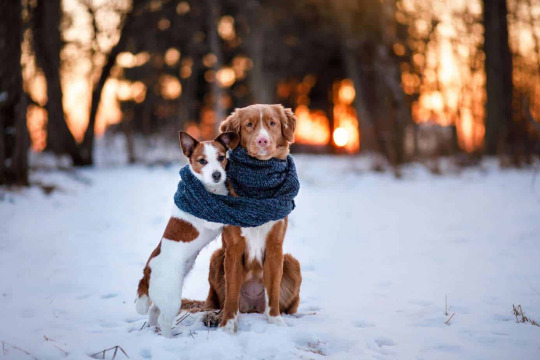
Invest in doggy outerwear - sweaters, hoodies, jackets, vests, even shoes! There's a whole market of pet clothing nowadays.
One of our favorite brands of K9 outerwear is Canada Pooch

It's important to note that not every dog's coat may be enough to keep them warm in the winter - especially puppies, small or hairless breeds, elderly dogs, or those with health issues. Just like with people, pets' cold tolerance can vary based on their coat, body fat stores, activity level, and health. Pets with heart disease, kidney disease, or metabolic diseases like diabetes and Cushing's might also have a harder time regulating their body temperatures.

Protect your dog's paws when it's snowing. Boots can help minimize contact with the ground and prevent snow and ice from getting lodged between their toes and causing frostbite. Like chapped lips, cracked paws can be annoying and painful, and built up snow and ice can irritate their sensitive skin between their toes.
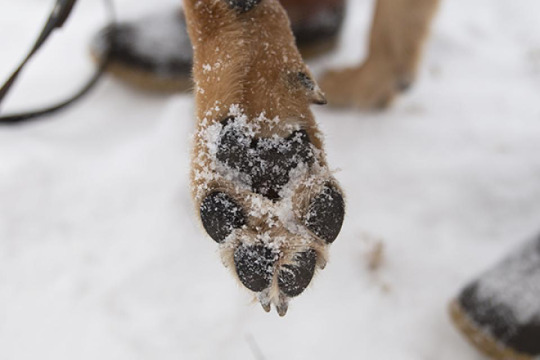
It might feel awkward at first for some dogs, so try to use positive reinforcement as they try to adjust to wearing their boots. Offer high-reward treats so they can learn to associate good things with their boots - when the boots are on, good things are going to happen! :)
youtube
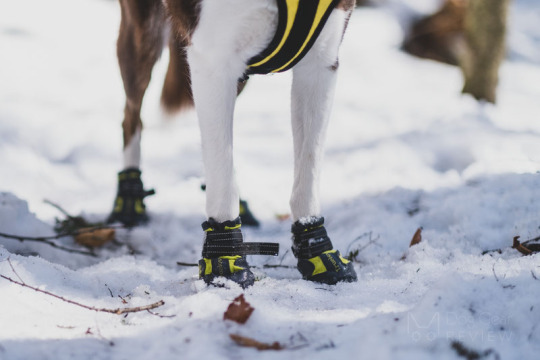
If boots still don't feel right for your dog, you can try applying paw balm or petroleum jelly-based products like Musher's Secret to keep your dog's paws safe and moisturized.

Just always be sure to wipe down and clean your dog's paws thoroughly with with a warm cloth when they come back inside. Sometimes salt and anti-freeze are put on sidewalks and driveways, which can cause chemical burns on your pet's paw pads or gastrointestinal issues if they try to lick it off.
Limit their time outdoors. Winter walks aren't always so magical. Know your dog's limits and shorten their walks if needed. If you can, reserve walks for the warmest parts of the day.
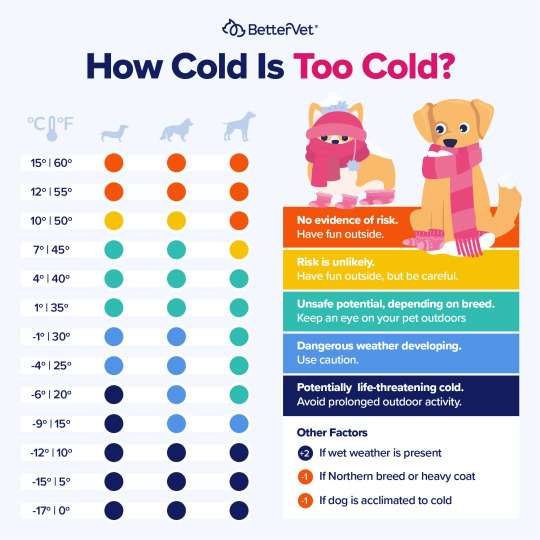
Signs to tell if your dog is too cold:
- Shaking, shivering, or trembling
- Hunched posture with tail-tucking
- Slowing down or reluctant to walk/move
- Lifting their paws off the ground
- Whining or barking
- Ears and nose feel very cold to the touch
Even if you decide to leave your dog in the car while you run an errand, it can still be dangerous if they are left for too long without any heat support when its below 30 degrees F outside. While cars can trap blazing temperatures in the summer and open risk for heatstroke, they can also trap freezing temperatures in the winter and open risk for hypothermia. Perhaps try to sit in your car without a jacket and see how long you can bare waiting in there without the heater on.
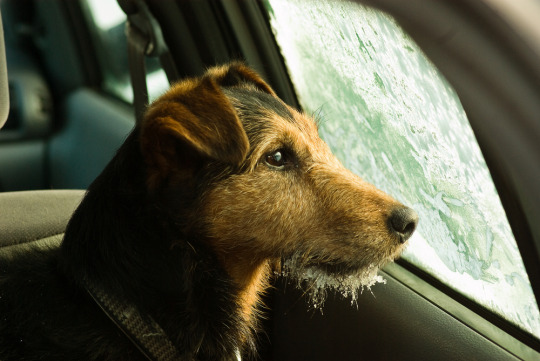
Provide choices! Give your dog more options for comfortable sleeping places with varying levels of bedding and blankets, in case they need to change their location for more or less warmth.

Set up cozy, wet-proof areas outdoors with heating lamps and wind barriers. Make sure kennels and igloos/houses are well-insulated and have enough space for them to walk in, turn around, and comfortably lay in.
youtube
Unless you have a healthy conditioned sled dog, I would not recommend letting them spend the night outdoors in the snow, without proper shelter and heat support. Watch how cold it can get in a simple dog house:
youtube
Serve warm food and water. At minimum, aim to make sure whatever they consume is at room temperature - but preferably just above their body temperature (101-103 F) when it's especially cold. Warming their food will also bring out their aroma and make it more enticing for them to eat.
If feeding kibble/dry or dehydrated, you can mix in some warm bone broth. If it's canned/wet food, avoid microwaving for too long, as this can make the food too hot and potentially deplete its nutrients. Instead, try warming up your dog's wet food with this technique:
As for home-cooked/fresh food, the Balance It Canine Plus supplement not only makes your dog's complete and balanced, but is actually formulated to withstand reheating/microwaving. Our personal favorite!
Below is a tutorial on how to utilize the Balance It system:
youtube
When selecting ingredients for your dog's food in the winter, consider including "warming" foods according to TCVM food energetics. Examples of these would be meats like lamb, goat, or venison, and vegetables and starches like sweet potatoes and oats.
Traditional Chinese medicine teaches that hot/warm food nourishes the body by bringing heat which improves circulation. To support this theory, some studies have found that food associated with heat consists of compounds that are on average lower in molecular weight, yet higher in protein and fat - which contribute to energy production, and magnesium and potassium - which contribute to blood pressure and nerve function.(https://www.sciencedirect.com/science/article/pii/S2666154320300247)
Here is a list of some hot/warm commercial pet food and treats:
- SideBySide Pet "Warming"
- Dr. Judy Morgan's Fire Element Diet
- Pet Tao "Blaze" Freeze Dried Raw Formula
- JustFoodForDogs Venison & Squash Recipe
- JustFoodForDogs Lamb & Rice Recipe
For more information on food energetics, watch this video:
youtube
2 notes
·
View notes
Text
So I like to think that the time Sanji spent shipwrecked on Buttfuck Nowhere, East Blue absolutely gave him some fucked up eating disorder. I mean we can sorta see a smidgen of it canonically--he's insistent on never wasting food, even using fish bones and guts in his dishes when they fell into that Navy base--but I'm talking REAL fucked up eating disorder. Can't stop looking at things and considering how he can cook it. Can't stop counting the calories in each morsel he lays his eyes on. He sees the nutritional value in the bark on trees and the grass under his feet. If his crew is ever placed in a starvation situation he has contingency plans out the ass. Nobody is going hungry if he can help it.
However he realizes one day that he does the same shit with human meat. He's got a fucked anti-starvation brain that looks at everything and wonders if he can cook it, and he subconsciously does the same thing with humans. And every fucking time he does it he needs to light another cig to calm himself down because that shit is weird and eating humans is gross (nevermind that he knows exactly what to avoid if push comes to shove--avoid the central nervous system, the brain most of all, livers and kidneys are too toxic for consumption, best meat found in the shoulders and calves, check with Chopper for blood diseases).
#filthposting#im in the process of writing smth about this because im really really hooked on the idea#definitely not because i have personal feelings regarding cannibalism and vinsmoke sanji#but also generally i just think i could make it work really really well if i play my cards right#especially since ive got some cooking knowledge alongside my cannibalism knowledge and could go in-depth about his preparation
18 notes
·
View notes
Text
Cat Nutrition - An Off-Topic Post
I've worked in the pet food industry for the last 7 years and it always shocks me how little people know about the nutritional needs for their cats/ pets in general.
A lot of people just follow what their parents did or whatever the vet or pet store recommends (often promoting their own brands).
Here's a big blurb of everything you should know about feeding your fur beans.
For those short on time here's the spark notes version:
Kibble is really bad for cats and was really only made for human convenience and profit- it dehydrates them which is one of the main causes for kidney disease which affects 1 in 3 cats and is ridiculously high carb - 3-5x more than what they need.
Even fancy feast or the lowest quality wet/canned food is better than the highest quality dry/kibble.
While Raw can have it's downsides if fed improperly, there's lots of balanced brands that can make it easy and is really the best for them, it's what their bodies are made to eat!
Picky cats:
Add warm water to their food.
Play with them before meal times.
Find 4-5 different foods they like and rotate so they don't get bored.
Do your own research! Find out what works best for you, don't blindly follow what vets tell you and what friends or family have been doing.
Here's everything to know about Cat and their role in the Pet Food Industry:
1. Cat are desert animals!
This means that they are made to be getting 80-90% of their moisture from their food! Most cats will only drink water from a bowl when they are severely dehydrated.
This is why feeding wet food (canned) or raw is so much more important.
2. Kibble is a new invention for Human Convenience!
Kibble has only been around for 67 years! The first kibble was invented in 1956. Back in the 40s during WWII there were sanctions put on the use of cans and metals, essentially removing the option of canned pet foods. This pushed companies to find an alternative, working with by products (left overs) from cereal companies they created a high-profit cheap food they could sell to customers that had a better shelf life.
-How is Kibble made?
Almost all kibble goes through a process called extrusion where the initial ingredients, meats, by-products and additives are processed under intense heat and pressure 4-5 times before they're cut to shape and sprayed with flavors and oils.
This process removes nutrients, vitamins and pretty much everything from the original ingredients.
Try cooking a high grade steak at max output on your oven 4-5 times and see if anything is really worth eating at that point.
-Veterinary Diets
In the late 60s, a generation after the invention of kibble, there became an increase in kidney and liver failures, prompting a French vet to create his own trademarked food - Royal Canin with Hill's Science Diet being created later in the US.
(Fun fact, Hill's has actually trademarked the term "prescription diet" so that no other pet food brand is allowed to use it in their packaging.)
3. Cats vs. Dogs - What's the difference?
While dogs are much more flexible in what they can eat, Cats are obligate carnivores.
A Carnivore (Dogs) does well on meat based diets, while
Obligate Carnivores (Cats) need a meat based diet in order to survive.
Broken down in food-
dogs ideally need 30% protein, 63% fat and 7% carb from their food cats need 53% protein, 35% fat and 12%.
4. Why does this matter and what does it mean for their food?
Dry foods are primarily carbohydrates. 35-50% on average.
This is 3-5x more than a cat needs in addition to the lack of protein, which is what keeps a cat functioning.
Grains - or carbs can be extremely detrimental to a cats body:
Carbohydrates turn into sugar in the body, meaning the more carbs a cat consumes, the more sugar, which increases their chances of getting diabetes.
In the wild, most cats choose to avoid eating the intestines of their prey, where most of the grains and fibre are kept, indicating cats also use very little to no fibre in their diets.
On top of that, the lack of moisture in kibble actually dehydrates cats, one of the primary reasons for kidney problems down the line, affecting 1 in 3 cats.
5. What do I feed my Cat?
Feed wet or raw!
At the end of the day, if your cat only eats fancy feast or whiskas, or if that's the only wet(canned) food you can afford, it's a huge step forward for their diets. These brands are going to be better than any of the highest quality dry foods you can find because it means they're getting the moisture and protein they need without the extra carb and salt content.
Raw foods have come a long way. They aren't all the frozen patties or having to home cook the meal with all these added supplements.
There's lots of complete brands out there in different formats that make it easy for everyone. Freeze-dried is a form of raw that you rehydrate and feed. Air-dried (most expensive) is fed like kibble, and is kind of a jerky texture.
If you're on raw, or with any food, make sure to wash your hands with soap before and after feeding and I recommend getting your cat dewormed twice a year for precautionary actions.
-Treats
the common ones like greenies, tempations are all kibble like treats, filled with carbs and salt, that make them irresistible but also horrible for them.
Single 1 ingredient treats are the best out there. Even a scrab of unseasoned chicken from dinner or salmon sashimi from a sushi night is a great alternative.
6. Reading the Label
Once you get into canned foods, there's hundreds of options. Here's a few things that help me decide what's worth it and what to avoid.
Starting from worst to best with the wording:
"Flavor" ie - "Beef flavor Dog food" it doesn't even need a certain percentage of beef, as long as it's technically detected in the food.
"With" ie - "Dinner with beef" - beef only has to be minimum 3% of the food.
25% rule - If the food has 25% or more of the main protein, it can be labelled as "Beef entree" or "lamb Dinner". If there's more than 1, they can be labelled together but must add up to 25% and be labelled in the order of their percentage. - ie "Lamb & Lamb Liver Entree"
95% rule - At least 95% of the food must be of the listed protein. "Chicken dog food"
Often - those with a 95% label will proudly show it, while the others you'll have to read to notice.
7. Kitten vs. Adult vs. Senior food
There's really only 4 categories a food can be put into -
Gestation/Lactation (for Mama cats)
Growth
Maintenance
All Life Stages
"Senior food" does not have a category as there is no clear definition on a change of nutritional needs as a cat ages.
While "Growth" is typically attributed to kittens, most wet foods will have kitten portioning as they are all life stages. The biggest difference is that kitten food is fattier and has some added nutrients needed for growth. These can also be found in any other canned food with the appropriate portioning.
8. Urinary Food
There's a lot of misconceptions about this. Brands will advertise Urinary dry food or the vet line - Kidney food. But if it's dry, as we now know, it dehydrates them, furthering the damage to the kidneys, making it extremely counter intuitive. Any wet food will be better than a dry "urinary" food to help treat this issue, ideally a low phosphorous brand. - Weruva is the most popular and has a low phosphorous line as well.
9. Fish
Fish is not a naturally occurring food for cats!
Cats only started eating fish when fishing became prominent in human civilizations.
Fish is the most common occurring allergy in cats! - some symptoms are constant itchiness, rashes, immediately throwing up, or butt dragging after a poop.
I personally recommend avoiding fish in cat foods, especially Tuna, if it's bad for us in large quantities due to the toxic build up of chemicals and things like mercury, imagine what it does to them.
10. Pickiness and Meal Time
Cats are notoriously picky or fussy or spoiled.
This is because they have 4 stages of food preference that need to be just right.
1 - smell
2 - taste
3 - texture / consistency
4 - how it sits in their stomach
It's hard to find exactly what they want and unfortunately there's no shortcut. It's really just trial and error.
Hot tips:
-Add warm water to their food - it's gross but cats like their food at prey body temperature, if it's cold to the touch for us, it's likely not that appealing for them either.
-Just like dogs, keeping a routine is incredibly important for cats. they're actually a lot more meticulous about routine than dogs are and will let you know exactly when breakfast and dinner time is.
Leaving the food out makes it less appealing for them.
If they don't eat breakfast, take the food away and they have to wait for dinner. Over time they'll eat until they're done during meal time.
-Play with them before food!
Cats are hunters, their goal for survival is catch, kill, eat, sleep etc.
Play with them near meal time, get them real worked up until they're exhausted, then put down food, they'll be much more likely to eat now that they're gotten all the hunting out of the way.
-I recommend having at least 4 or 5 different flavors or brands that your cat likes, to rotate through so they don't get bored and you don't end up at square 1 when they decide that one they like isn't good enough anymore.
Keep in mind: Beef, Lamb & Duck are often high in fat and should be used as a once in a while protein.
Chicken & Turkey are the best proteins.
Even if your cat doesn't like chicken from one brand, they could go nuts for one from a different brand or even the same brand with a different texture. Try them out and see, don't eliminate a whole protein so easily because of a few that get turned down.
I think that's a wrap. Food really makes a world of a difference for these guys, their whole world revolves around it and getting it right can mean years of a difference. - For reference, the average life expectancy for indoor cats is 15-20 years old!
For the devils' advocates - yes there are cats that have lived long lives on the worst quality dry foods, but they're really the exceptions, same as people. There's definitely people who have lived to their 90s or older surviving off McDonalds or the equivalent, but that's not really the kind of quality of life or food you want to be giving your pet who is entirely dependent on your choices at the pet store.
If you stuck around to the end, I appreciate you, and I'm glad there are other people out there who care just as much about their furry friends as I do.
I'm more than willing to discuss any questions, even it it's not directly about their nutrition!
Side note - some of the canned food brands I'm a big fan of:
Feline Natural
Rawz
Tiki Cat
Nature's Logic
Identity
Weruva/BFF
#cats#cat#cats of tumblr#cat nutrition#cat food#pet nutrition#wet food#dry food#raw food#kibble#canned food#raw feeding#picky cats#reading the label#cat food labels#pet food#cat health#pet foods
6 notes
·
View notes